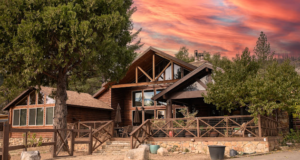A Closer Look At Basket Weaving –
From the new book Willow Creek History, by Marcia Penner Freedman, a chapter explores the Mono tradition of basket weaving (p 33).
The chapter begins with a quotation from Gaylen Lee’s book walking where we lived: I know that nothing ends, all of life goes on, they are still here, all of the old people are still here in other forms, continuing to teach us, if we will only listen.
In this chapter, Marcia explores basketry as part of the Mono culture:
Basketry, in the Mono tradition, is more than simply producing baskets. In times past, basket making played an integral part in the daily life of the Mono family.The Mono woman, typically with children and grandchildren in tow, would venture out to her favorite gathering spots to cut the sticks and dig the roots that would go into her family’s baskets.
Ruby Pomona, Gaylen Lee’s mother, has fond memories of walking in the Sierra Nevada with her grandmother, who taught her about the different materials she used to make her basket, which…include redbud, sage and white root.
Gather places exist throughout the Willow Creek watershed. Locally, people gather in the areas around Manzanita Lake and the north and south forks of Willow Creek…. Not only did the Mono woman know how to gather, she also knew when to gather. She understood the elements and the land and knew such things as that the redbud stick is most pliable and the red color the deepest if cut during the coldest days of wintertime and that sourberry is good when cut in spring as well as winter. She had practical skill in how to keep the materials supple by burying them in the moist earth and how to seal water storage baskets with pitch from the bull pine.
Bunnell, in his Discovery of the Yosemite, remarked that the Native American baskets used for boiling water were “strong as wire, and almost as durable.”
The spiritual life of the Mono finds expression in basket making, affecting when to weave, when not to weave and what designs to use. Gathering areas were considered sacred, not to be owned or controlled. They were protected by families from generation to generation.
Lois Connor’s grandmother taught her about the spiritual connection to basket making. For Connor, it’s everything. The plants have spirits. The animal spirits live in the designs. They draw the animal to you.
“One of our traditions, “Connor explains,” is the sun goes down, you put your basket away.” Even today, one commonly finds a woman working on her basket straight through from sunup to sundown, then putting it away for the night and beginning again with the first light of the next day.
Rosalie taught Lois that a weaver has all the baskets inside herself waiting to come out. The basket maker might visualize the design in a dream then weave it into the basket as she works on it. Sometimes the spirit can take its time revealing what basket is ready to come out. Or, the weaver might have dreamed that she was supposed to make a basket with a big rattlesnake design on it, but then the spirit will change design right in the middle of her work.
WILLOW CREEK HISTORY is available from local bookstores and from the Coarsegold Historic Museum.



